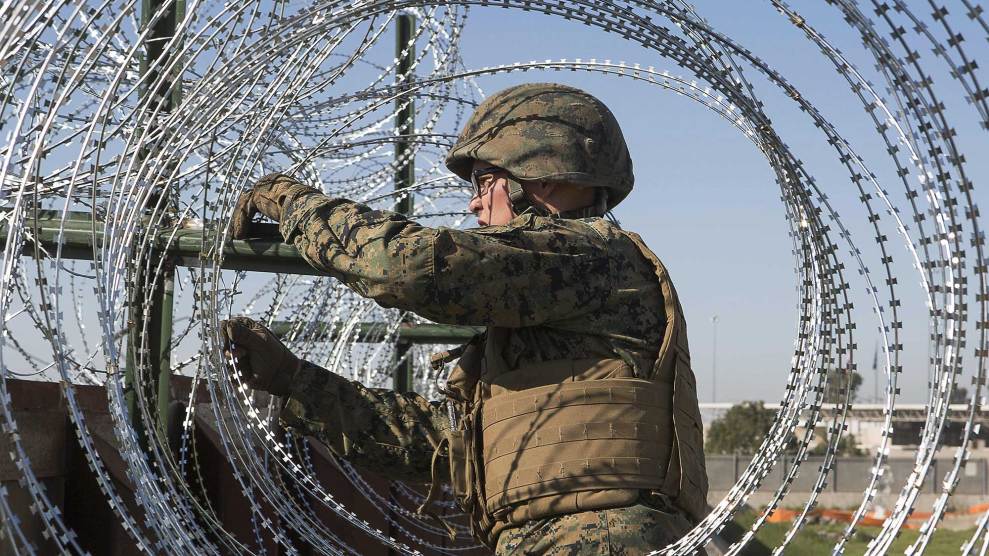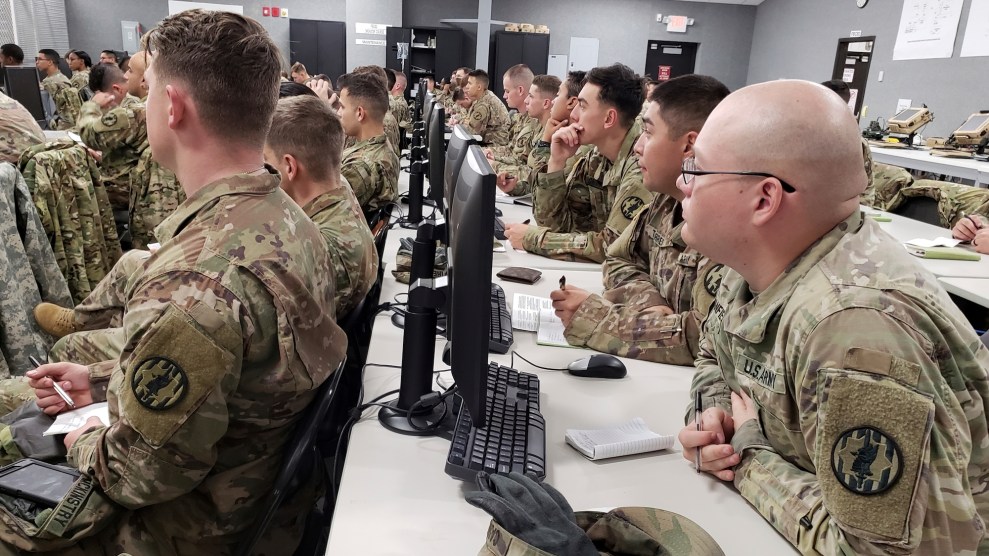
US Marines installing concertina wire at a border crossing near San Diego in NovemberAsia J. Sorenson/ZUMA
Back when President Donald Trump sent thousands of soldiers to the US-Mexico border in the fall, his critics pointed out that the military’s presence was useless and that they couldn’t do much to secure the border. There was one thing, however, that they could do: Put up tons of concertina wire along the border line—so much, in fact, that one mayor is now asking them to take it down.
On Wednesday night, Arturo Garino, the mayor of Nogales, Arizona, will present a resolution to the City Council to remove the “excessive” concertina wire on the fence along the city’s border with Nogales, Mexico. “I don’t see any need for it, but somebody in Washington thinks we need it to show force,” Garino told Mother Jones on Tuesday. “It’s over-the-top.”
Adam Isacson, the director of defense oversight at the Washington Office on Latin America, tweeted these photos of downtown Nogales (taken by the Nogales International‘s Jonathan Clark) on Tuesday morning:
Look what the US military deployment did to the border fence in downtown Nogales, Arizona. This makes us look like a nation that's completely lost its mind: https://t.co/0ui7zBYHsV pic.twitter.com/Godx7INhcp
— Adam Isacson (@adam_wola) February 5, 2019
Most of the border areas in Nogales already have barriers and fencing that are 18 to 25 feet tall. In recent months, troops deployed to the border added a row of concertina wire (or razor wire, as it’s more commonly known) to the top of that fencing. But last Saturday, the troops added even more rows, essentially covering the entire border fence.
Garino said the new wire is too aggressive and is a “business killer” because it’s right in the downtown area. The rows of razor wire, he said, give the impression that there is imminent danger—the kind that might make visitors think twice before hanging around Nogales.
And beyond that, he argued, it’s a safety hazard to the city’s residents. “There’s homes that are maybe 10 to 15 feet away, and there’s nothing that’ll stop a child or anybody that’s walking there from getting close to the concertina wire—and it’s considered a lethal wire,” Garino said.
Last weekend, the Defense Department received an additional request to send troops to install more razor wire along the border, said department spokesman Captain William Speaks. The troops don’t decide where to install the wire and how much of it to put up, Speaks noted—US Customs and Border Protection makes that call. (Officials from the US Border Patrol, a division of CBP, did not respond for a request for comment.) While additional barriers were previously put up at official ports of entry, Speaks said, now the directive is to cover hundreds of miles of the border over the next 60 days.
Since last October, more than 5,000 troops have been deployed to the southern border at the request of Trump, who initially said they were needed to help border agents in anticipation of the migrant caravans. But because the military does not have the authority to enforce immigration laws, the troops have been helping by doing logistical support, digging ditches, flying helicopters that transport border agents, monitoring cameras, and installing rows and rows of razor wire.
By the end of February, Speaks anticipates to have 4,300 troops deployed along the border. When I asked him if the troops felt this was a good use of their time, he said he hasn’t heard of any complaints because they’re gaining experience on things they would do on missions overseas. “Border security is part of national security, and DOD has a role to play, but that role is in support of the appropriate authorities like Customs and Border Protection,” he said.
Been checking out the additional concertina wire at Nogales. They’re putting it up west of downtown now. I counted 31 more bales in storage. pic.twitter.com/4un8yplf5b
— Tim Steller (@senyorreporter) February 5, 2019
Mayor Garino and other Nogales officials will discuss his resolution condemning the use of concertina wire “as an indiscriminate use of lethal force by the federal government” at Wednesday’s City Council meeting. Garino told me that the placement of the razor wire also goes against a city ordinance that says this type of wire should only be placed six to eight feet above ground.
Ahead of last weekend’s wire installation, Garino reached out to CBP officials—with whom he said he typically has a good relationship—but “they didn’t want to take my call.” He wanted to know why the need for this now, and why they covered the US side of the fence.
“Doesn’t it look like they’re preventing someone from climbing from here into Mexico?” Garino joked.














